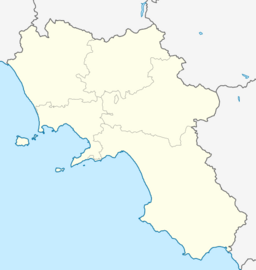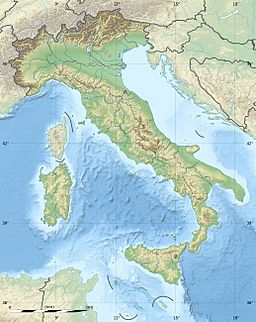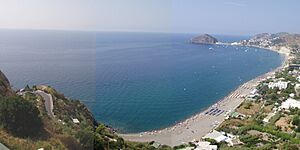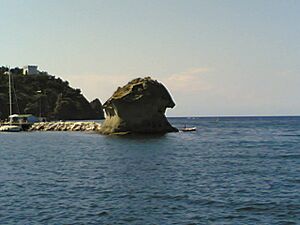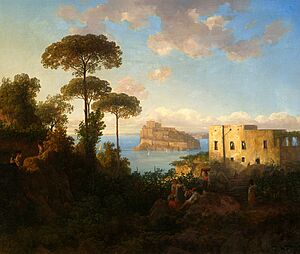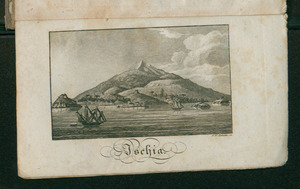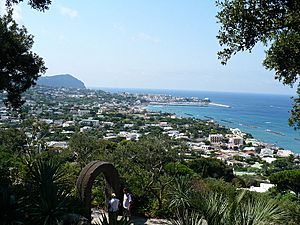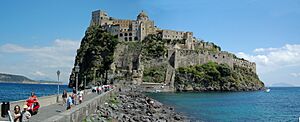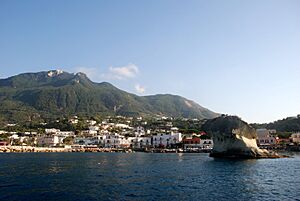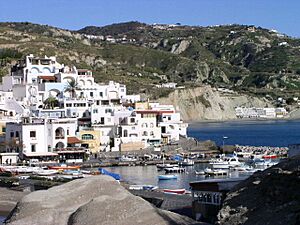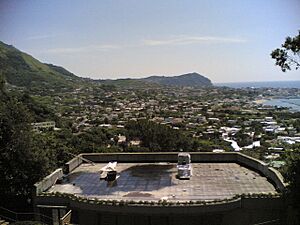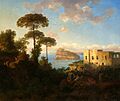Ischia facts for kids
Quick facts for kids Ischia |
|
|---|---|
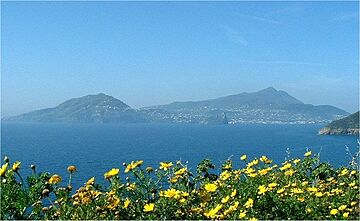
View of Ischia from Procida
|
|
| Highest point | |
| Elevation | 789 m (2,589 ft) |
| Geography | |
| Geology | |
| Mountain type | Complex volcano |
| Last eruption | January to March 1302 |
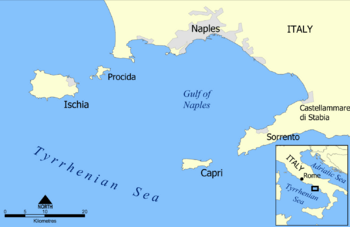 |
|
| Geography | |
|---|---|
| Location | Tyrrhenian Sea |
| Area | 46.3 km2 (17.9 sq mi) |
| Highest elevation | 789 m (2,589 ft) |
| Highest point | Mount Epomeo |
| Administration | |
|
Italy
|
|
| Region | Campania |
| Metropolitan City | Naples |
| Largest settlement | Ischia (pop. 18,253) |
| Demographics | |
| Population | 62,027 (2009) |
| Pop. density | 1,339.7 /km2 (3,469.8 /sq mi) |
Ischia is a beautiful volcanic island in the Tyrrhenian Sea. It's located at the northern end of the Gulf of Naples, about 30 kilometers from the city of Naples. Ischia is the largest of the Phlegrean Islands. People have lived here since the Bronze Age. Ancient Greeks founded a trading post here around 8th or 9th century BCE. They called it Pithekoūsai, which means "Monkey Island."
The island is shaped a bit like a trapezoid. It's about 10 kilometers from east to west and 7 kilometers from north to south. Ischia has about 34 kilometers of coastline and covers an area of 46.3 square kilometers. Most of the island is mountainous. The highest point is Mount Epomeo, which is 788 meters tall. Many people live on Ischia, with over 60,000 residents. The main town on the island is also called Ischia. Other towns include Barano d'Ischia, Casamicciola Terme, Forio, Lacco Ameno, and Serrara Fontana.
Contents
Island Features: Geology and Geography
Ischia is a complex volcano located southwest of the Campi Flegrei area. This is on the western side of the Bay of Naples. About 56,000 years ago, a huge eruption formed a large caldera. This caldera covers almost the entire island and some of the seabed around it.
The highest point, Mount Epomeo (788 meters), is a special type of volcanic uplift. It's made of green tuff rock that was pushed up from under the sea. The island's volcanic activity has been shaped by movements in the Earth's crust. These movements created high blocks (horsts) and low areas (grabens). Over the last 33,000 years, the land has risen by at least 800 meters. Many smaller volcanoes have formed around this uplifted block. The last time Ischia erupted was in 1302. This eruption created a lava flow called Arso, which reached the northeast coast.
The waters around Ischia are very healthy and full of life. They are home to about seven types of whales and dolphins. This includes large fin and sperm whales. Special research programs help monitor and protect these amazing sea creatures.
Monte Epomeo is often thought of as a volcano. However, it's actually a tectonic horst. This means it's a block of the Earth's crust pushed up by pressure from magma below. The real volcanic activity on the island happens along cracks near Monte Epomeo.
Ancient Greek historian Timeo wrote about a tsunami that hit Ischia. This happened after volcanic activity on Epomeo. The sea pulled back far, then rushed back, covering the island. This shows how powerful the island's natural forces can be.
What's in a Name? The Island's History
The ancient Greeks called their settlement on Ischia Pithekoussai. This name led to the Latin name Pithecusa. The meaning of this name is a bit of a mystery!
Some people think the name comes from pithekos, meaning "monkey." This might refer to a myth about people turned into monkeys. Others, like Pliny the Elder, believed it came from pythos, meaning "amphora" (a type of jar). This makes sense because archaeologists have found many ancient pottery pieces on the island. These include wine amphorae.
Another idea is that the name describes the island's pine forests. Words like "Pitueois" (rich in pines) or "pituis" (pine cone) could be the source. This would mean "island of resin," which was used to make wine jars waterproof. The Romans also called the island Aenaria. This name might be linked to metal workshops on the eastern coast.
The name "Ischia" first appeared in a letter in 812. Pope Leo III wrote to Charlemagne, calling the island Iscla maior. Some experts think "Ischia" comes from a Phoenician word, i-schra, meaning "black island." Phoenician traders were present on the island a very long time ago.
Island History: A Journey Through Time
Ancient Times
People lived on Monte Vico from the Bronze Age. This is known from pottery found there. In the 8th century BC, Greeks from Euboea came to Ischia. They set up a trading post to trade with the Etruscans on the mainland. This settlement, Pithecusae, was a mix of Greeks, Etruscans, and Phoenicians. It became very successful because of its good harbor and safety from attacks. By 700 BC, Pithecusae had between 5,000 and 10,000 people.
An important discovery was made in 1953. A ceramic cup, called "Nestor's Cup," was found in a grave. It has some of the earliest Greek writing on it, from around 730 BC. This writing is important because the Latin alphabet came from the Greek alphabet. Some scholars even think it's the oldest written reference to the famous story of the Iliad.
In 474 BC, Hiero I of Syracuse helped the people of Cumae against the Etruscans. He defeated them at sea and took over Ischia. He left soldiers to build a fortress. Later, the original soldiers left because of volcanic eruptions. The island was then taken over by people from Naples. The Romans took control of Ischia in 322 BC.
From Roman Times to the 16th Century
In 6 AD, Augustus gave Ischia back to Naples. Ischia faced many challenges over the centuries. It was attacked by different groups, including the Heruli and Ostrogoths. It became part of the Eastern Roman Empire. Later, it was given to Naples. The island was attacked by Saracens in 813 and 847.
In 1130, the Norman Roger II of Sicily took control. The island was raided by the Pisans. It then came under the rule of different European families, like the Hohenstaufen and Angevins. After a rebellion in 1282, the island changed hands many times.
In 1302, the island's last eruption happened. The people had to leave and stayed away for four years. Ischia suffered a lot during conflicts between different ruling families.
In 1438, Alfonso V of Aragon took over the castle. He built a stone bridge connecting the castle to the island. He also carved a large tunnel, which you can still see today. In 1495, Ferdinand II of Naples took control of the castle. He left it to Innico d'Avalos, who bravely defended it from the French. This started the D'Avalos family's rule on the island, which lasted until the 18th century.
16th to 18th Centuries
Throughout the 1500s, pirates from North Africa attacked Ischia. In 1543 and 1544, Hayreddin Barbarossa attacked the island, taking 4,000 people prisoner. Later, Dragut Rais also attacked. As pirate attacks became less common, people started to move out of the castle. This is when the historic center of Ischia town began to grow.
Since the 18th Century
In 1729, the D'Avalos family's rule ended, and the island became state property. In 1734, the Bourbons took control. Ischia briefly joined the Republic of Naples in 1799. However, Lord Nelson's forces quickly ended the revolt. In 1806, the French occupied the island.
In the 19th century, Ischia became a popular place for European royalty to visit.
On July 28, 1883, a strong earthquake destroyed the villages of Casamicciola Terme and Lacco Ameno.
In the early 1900s, Ischia became a famous place for artists. Writers and painters from all over the world came here. Many famous artists lived or stayed on the island. Spa tourism became popular again in the 1950s. Many writers, composers, and artists lived in Forio. Famous people like Elizabeth Taylor and Luchino Visconti also visited for filming.
On August 21, 2017, Ischia had a 4.2 magnitude earthquake. Sadly, two people died, and 42 were injured.
Today, Ischia is a very popular tourist spot. It welcomes up to 6 million visitors each year. Most visitors come from Italy, Germany, and the United Kingdom. Ischia is easy to reach by ferry from Naples. The island has many thermal spas, making it popular for "wellness" holidays.
Ischia in Books and Movies
Events and Festivals
Ischia hosts the Ischia Film Festival. This is an international movie competition held in June or July. It celebrates films that highlight the beauty and value of local places.
Famous Visitors and Works
- The Italian politician Giuseppe Garibaldi stayed on the island to recover from an injury.
- The Russian revolutionary Mikhail Bakunin lived in Ischia from 1866 to 1867.
- In 1948, poet W. H. Auden wrote his poem "In Praise of Limestone" here.
- In 1949, British composer William Walton moved to Ischia. He built a house called La Mortella and his wife, Susana, created a magnificent garden there. Walton lived on the island until he passed away in 1983.
- German composer Hans Werner Henze lived on the island from 1953 to 1956.
- Samuel Taylor's play Avanti! (1968) takes place on Ischia.
- Hergé's comic series, The Adventures of Tintin, ends in Ischia.
- French novelist Pascal Quignard set parts of his novel Villa Amalia (2006) on the island.
- In Elena Ferrante's Neapolitan Novels, the island is where the main characters spend several summer holidays.
Filming Locations
Many movies have been filmed on Ischia, including:
- The American adventure film The Crimson Pirate (1952) was filmed here.
- Parts of Purple Noon (1959), starring Alain Delon, were filmed on the island.
- Avanti! (1972), starring Jack Lemon, was filmed here.
- Part of Cleopatra (1963), starring Elizabeth Taylor, was filmed on Ischia.
- Ischia Ponte was used as "Mongibello" in the film The Talented Mr. Ripley (1999).
- The American film And While We Were Here (2012) was filmed on the island.
- Castello Aragonese was used as 'Riva's Fortified Fortress' in Men in Black: International (2019).
Ischia's Wines
Ischia is known for its special wines. The island has a Denominazione di origine controllata (DOC) area. This means its wines meet certain quality standards. Both red and white wines are made here, but white wines make up almost 80% of the island's wine production. The vineyards grow in volcanic soil. This soil is rich in pumice, phosphorus, and potassium, which are good for grapes.
Main Sights: Places to Explore
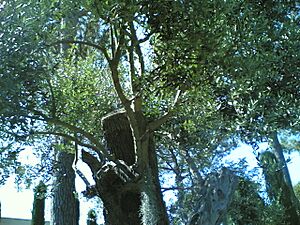
Aragonese Castle
The Aragonese Castle (Castello Aragonese) is built on a rock near the island. It was first built in 474 BC by Hiero I of Syracuse. Two towers were also built to watch for enemy ships. Over time, different groups controlled the castle. In 1441, Alfonso V of Aragon built a stone bridge to connect the rock to the island. He also made the walls stronger to protect people from pirates.
Around 1700, about 2,000 families lived on the islet. There was a convent, an abbey, a bishop, and a prince with soldiers. There were also thirteen churches! In 1912, the castle was sold to a private owner. Today, it's the most visited monument on the island. You can reach it through a tunnel with large openings that let in light. There's also a modern lift for easier access. Inside, you can visit the Church of the Immacolata and the Cathedral of Assunta.
Gardens of La Mortella
These beautiful gardens are in Forio-San Francesco. They used to belong to the English composer William Walton. He lived in a villa next to the gardens with his wife, Susana. When Walton came to the island in 1946, he asked Russell Page to design the garden. Amazing tropical and Mediterranean plants were planted, and some have grown very large. The gardens offer wonderful views of Forio town and its harbor. There's also a museum about William Walton's life and work. A special room hosts musical performances by famous artists.
Villa La Colombaia
Villa La Colombaia (meaning "The Dovecote") is located in Lacco Ameno and Forio. This villa is surrounded by a lovely park. It was built by Luigi Patalano, a local journalist. Today, it's a cultural center and museum dedicated to Luchino Visconti. The center hosts many cultural events, like music, cinema, theater, and art shows. Both the villa and the park are open to visitors.
Other Interesting Places
- Sant'Angelo (in the town of Serrara Fontana)
- Maronti Beach (Barano d'Ischia)
- Church of the Soccorso (Forio)
- Piazza S.Restituta, with fancy shops (Lacco Ameno)
- Bay of Sorgeto, with warm thermal springs (Panza)
- Poseidon Gardens – a spa with many thermal pools (Panza)
- Citara Beach (Panza)
- English's Beach (Ischia)
- Pitthekoussai Archaeological Museum
- The Angelo Rizzoli Museum
Protecting Ischia's Environment
The number of people living on Ischia and the number of tourists visiting has grown a lot. This has put some pressure on the island's environment. Many areas that were once used for farming have been built on.
To help reduce pollution from cars, Ischia started a special project in 2017 called "Green Island." This project aims to make transportation on the island more environmentally friendly.
Images for kids
-
Ancient Olive tree in La Mortella
See also
- List of islands of Italy
- List of castles in Italy
- List of volcanoes in Italy
- Castello d'Ischia Lighthouse
- 2017 Ischia earthquake


